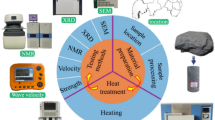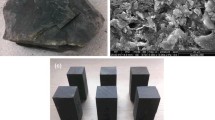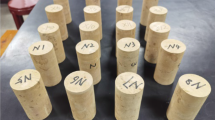Abstract
Understanding the influence of water and temperature on the mechanical behaviors of coal measure rocks is important for deep coal resource exploitation. Using an electro-hydraulic servo-controlled testing system (MTS816) with a self-designed thermostatic water tank, a series of water absorption experiments and uniaxial compression experiments were performed on mudstone and sandstone samples that were immersed in water under different temperature conditions (from 25 to 95 °C). The water absorption characteristics at different temperatures and the effect of water and temperature on the mechanical strength, deformation and failure mode of the samples under uniaxial compression were systematically analyzed. In addition, computerized tomography (CT) scanning was used to examine the microstructural changes in the mudstone and sandstone before and after water saturation at different water temperatures. The results from the water absorption tests show that the water content of the mudstone and sandstone samples kept increasing with immersion time until a saturated state was reached, with the trend generally following an exponential law. The higher water temperature allowed additional water absorption in the saturated mudstone, but less water absorption in the saturated sandstone. The mechanical tests suggest that the presence of water can significantly reduce the mechanical properties of the coal measure rocks. Decreases in the uniaxial compressive strength (UCS) of 76.0 and 38.9 % and the elastic modulus of 68.1 and 48.5 % were observed in the mudstone and sandstone, respectively, because of water saturation at room temperature. Moreover, the water-weakening effect was sensitive to water temperature, and as the water temperature increased from 25 to 95 °C, the UCS and elastic modulus decreased linearly in the saturated mudstone by 53.8 and 70.4 %, respectively, and increased linearly in the saturated sandstone by 21.3 and 20.2 %, respectively. The increasing water temperature also promoted a transition in the saturated mudstone from brittle to ductile behavior, but it had a negligible effect on the failure mode of the saturated sandstone. The CT scanning tests demonstrated that new fractures are produced inside the mudstone after water saturation and that the increasing temperature can exacerbate such water-induced damage. However, no obvious fractures were observed in the CT images of the sandstone at room temperature or at high water temperatures, and the water-induced damage in the sandstone appeared as the micro-fractures at a scale below the CT resolution.













Similar content being viewed by others
References
Al-Shayea NA, Khan K, Abduljauwad SN (2000) Effects of confining pressure and temperature on mixed-mode (I–II) fracture toughness of a limestone rock. Int J Rock Mech Min 37:629–643. doi:10.1016/S1365-1609(00)00003-4
Atkinson BK (1984) Subcritical crack growth in geological materials. J Geophys Res 89:4077–4114
Baud P, Zhu W, Wong TF (2000) Failure mode and weakening effect of water on sandstone. J Geophys Res Solid Earth (1978–2012) 105:16371–16389
Benzagouta MS, Amro MM (2009) Pressure and temperature effect on petrophysical characteristics: carbonate reservoir case. In: SPE Saudi Arabia Section Technical Symposium. Society of Petroleum Engineers
Brede M (1993) The brittle-to-ductile transition in silicon. Acta Metall Mater 41:211–228. doi:10.1016/0956-7151(93)90353-T
Casey WH, Sposito G (1992) On the temperature dependence of mineral dissolution rates. Geochim Cosmochim Acta 56:3825–3830
Ciantia MO, Castellanza R, Crosta GB, Hueckel T (2014) Effects of mineral suspension and dissolution on strength and compressibility of soft carbonate rocks. Eng Geol. doi:10.1016/j.enggeo.2014.10.024
Cnudde V, Boone M (2013) High-resolution X-ray computed tomography in geosciences: a review of the current technology and applications. Earth Sci Rev 123:1–17
Erguler ZA, Ulusay R (2009) Water-induced variations in mechanical properties of clay-bearing rocks. Int J Rock Mech Min 46:355–370. doi:10.1016/j.ijrmms.2008.07.002
Feng XT, Chen S, Li S (2001) Effects of water chemistry on microcracking and compressive strength of granite. Int J Rock Mech Min 38:557–568. doi:10.1016/s1365-1609(01)00016-8
Feucht L, Logan JM (1990) Effects of chemically active solutions on shearing behavior of a sandstone. Tectonophysics 175:159–176
Franklin J (1979) Suggested methods for determining water-content, porosity, density, absorption and related properties and swelling and slake-durability index properties. 2. Suggested methods for determining swelling and slake-durability index properties. Int J Rock Mech Min 16:151–156
Gao Y, Wong LNY, Gao F (2013) Finite deformation analysis on sandstone subjected to thermo-hydro-mechanical (THM) Coupling. Rock Mech Rock Eng 48:159–177
Goodman RE (1989) Introduction to rock mechanics, 2nd edn. Wiley, New York
Hawkins A, McConnell B (1992) Sensitivity of sandstone strength and deformability to changes in moisture content. Q J Eng Geol Hydrogeol 25:115–130
He M (2014) Latest progress of soft rock mechanics and engineering in China. J Rock Mechan Geotech Eng 6:165–179. doi:10.1016/j.jrmge.2014.04.005
He M, Qian Q (2010) The basis of deep rock mechanics. Science Press, Beijing (in Chinese)
He M, Xie H, Peng S, Jiang Y (2005) Study on rock mechanics in deep mining engineering. Chin J Rock Mech Eng 24:2803–2813
Heard H (1980) Thermal expansion and inferred permeability of climax quartz monzonite to 300 °C and 27.6 MPa. Int J Rock Mechan Min Sci Geomechan Abstr 17:289–296
Homand-Etienne F, Houpert R (1989) Thermally induced microcracking in granites: characterization and analysis. Int J Rock Mech Min Sci Geomech Abstr 26:125–134
Huang S, Xia K (2015) Effect of heat-treatment on the dynamic compressive strength of Longyou sandstone. Eng Geol 191:1–7. doi:10.1016/j.enggeo.2015.03.007
Huang S, Xia K, Yan F, Feng X (2010) An experimental study of the rate dependence of tensile strength softening of Longyou sandstone. Rock Mech Rock Eng 43:677–683
Jiang Q, Cui J, Feng X, Jiang Y (2014) Application of computerized tomographic scanning to the study of water-induced weakening of mudstone. Bull Eng Geol Environ 73:1293–1301
Kang Y, Liu Q, Xi H (2014) Numerical analysis of THM coupling of a deeply buried roadway passing through composite strata and dense faults in a coal mine. Bull Eng Geol Environ 73:77–86
Karfakis M, Akram M (1993) Effects of chemical solutions on rock fracturing. Int J Rock Mech Min Sci Geomech Abstr 30:1253–1259
Keshavarz M, Pellet F, Loret B (2010) Damage and changes in mechanical properties of a gabbro thermally loaded up to 1,000 °C. Pure Appl Geophys 167:1511–1523
Lasaga AC (1984) Chemical kinetics of water-rock interactions. J Geophys Res Solid Earth (1978–2012) 89:4009–4025
Liu X, Gao H, Liang L (2011) Study of temperature and confining pressure effects on porosity and permeability in low permibility sandstone. Chin J Rock Mech Eng 30:3771–3778 (in Chinese)
Morrow C, Moore DE, Lockner D (2000) The effect of mineral bond strength and adsorbed water on fault gouge frictional strength. Geophys Res Lett 27:815–818
Nara Y, Morimoto K, Yoneda T, Hiroyoshi N, Kaneko K (2011) Effects of humidity and temperature on subcritical crack growth in sandstone. Int J Solids Struct 48:1130–1140. doi:10.1016/j.ijsolstr.2010.12.019
Nara Y, Yamanaka H, Oe Y, Kaneko K (2013) Influence of temperature and water on subcritical crack growth parameters and long-term strength for igneous rocks. Geophys J Int 193:47–60
Poulsen BA, Shen B, Williams DJ, Huddlestone-Holmes C, Erarslan N, Qin J (2014) Strength reduction on saturation of coal and coal measures rocks with implications for coal pillar strength. Int J Rock Mech Min 71:41–52. doi:10.1016/j.ijrmms.2014.06.012
Ramos da Silva M, Schroeder C, Verbrugge J-C (2008) Unsaturated rock mechanics applied to a low-porosity shale. Eng Geol 97:42–52. doi:10.1016/j.enggeo.2007.12.003
Reviron N, Reuschlé T, Bernard J-D (2009) The brittle deformation regime of water-saturated siliceous sandstones. Geophys J Int 178:1766–1778
Simpson C (1985) Deformation of granitic rocks across the brittle-ductile transition. J Struct Geol 7:503–511. doi:10.1016/0191-8141(85)90023-9
Sygała A, Bukowska M, Janoszek T (2013) High temperature versus geomechanical parameters of selected rocks-the present state of research. J Sustain Min 12:45–51
Tang CA, Liu H, Lee P, Tsui Y, Tham L (2000) Numerical studies of the influence of microstructure on rock failure in uniaxial compression—part I: effect of heterogeneity. Int J Rock Mech Min 37:555–569
Tian H, Ziegler M, Kempka T (2014) Physical and mechanical behavior of claystone exposed to temperatures up to 1000 °C. Int J Rock Mech Min 70:144–153. doi:10.1016/j.ijrmms.2014.04.014
Van Eeckhout EM (1976) The mechanisms of strength reduction due to moisture in coal mine shales. Int J Rock Mech Min Sci Geomech Abstr 13:61–67
Vásárhelyi B (2005) Statistical analysis of the influence of water content on the strength of the Miocene limestone. Rock Mech Rock Eng 38:69–76
Vásárhelyi B, Ván P (2006) Influence of water content on the strength of rock. Eng Geol 84:70–74
Wang L, Bornert M, Héripré E, Chanchole S, Pouya A, Halphen B (2015) The mechanisms of deformation and damage of mudstones: a micro-scale study combining ESEM and DIC. Rock Mech Rock Eng 48:1913–1926
Wasantha PLP, Ranjith PG (2014) Water-weakening behavior of Hawkesbury sandstone in brittle regime. Eng Geol 178:91–101. doi:10.1016/j.enggeo.2014.05.015
Wong L, Maruvanchery V, Liu G (2015) Water effects on rock strength and stiffness degradation. Acta Geotech 1–25. doi:10.1007/s11440-015-0407-7
Yang S, Jing H, Cheng L (2014) Influences of pore pressure on short-term and creep mechanical behavior of red sandstone. Eng Geol 179:10–23. doi:10.1016/j.enggeo.2014.06.016
Yilmaz I (2010) Influence of water content on the strength and deformability of gypsum. Int J Rock Mech Min 47:342–347. doi:10.1016/j.ijrmms.2009.09.002
Zhang L, Mao X, Lu A (2009) Experimental study on the mechanical properties of rocks at high temperature. Sci China Ser E Technol Sci 52:641–646. doi:10.1007/s11431-009-0063-y
Zhang N, He M, Liu P (2012) Water vapor sorption and its mechanical effect on clay-bearing conglomerate selected from China. Eng Geol 141–142:1–8. doi:10.1016/j.enggeo.2012.04.007
Zhang L, Mao X, Liu R, Guo X, Ma D (2013) The mechanical properties of mudstone at high temperatures: an experimental study. Rock Mech Rock Eng 1–6
Zhang F, Hu D, Xie S, Shao J (2014) Influences of temperature and water content on mechanical property of argillite. Eur J Environ Civil Eng 18:173–189
Zhou C, Tan X, Dend Y, Zhang L, Wang J (2005) Research on softening micro-mechanism of special soft rocks. Chin J Rock Mech Eng 24:394–400 (in Chinese)
Zhu WC, Tang CA (2004) Micromechanical model for simulating the fracture process of rock. Rock Mech Rock Eng 37:25–56. doi:10.1007/s00603-003-0014-z
Zuo JP, Xie HP, Dai F, Ju Y (2014) Three-point bending test investigation of the fracture behavior of siltstone after thermal treatment. Int J Rock Mech Min 70:133–143
Acknowledgments
We gratefully acknowledge the support provided by the Fundamental Research Funds for the Central Universities (Grant No. 2014QNB42) and the National Natural Science Foundation of China (NSFC, Grant No. 51404245).
Author information
Authors and Affiliations
Corresponding author
Rights and permissions
About this article
Cite this article
Lu, Y., Wang, L., Sun, X. et al. Experimental study of the influence of water and temperature on the mechanical behavior of mudstone and sandstone. Bull Eng Geol Environ 76, 645–660 (2017). https://doi.org/10.1007/s10064-016-0851-0
Received:
Accepted:
Published:
Issue Date:
DOI: https://doi.org/10.1007/s10064-016-0851-0




